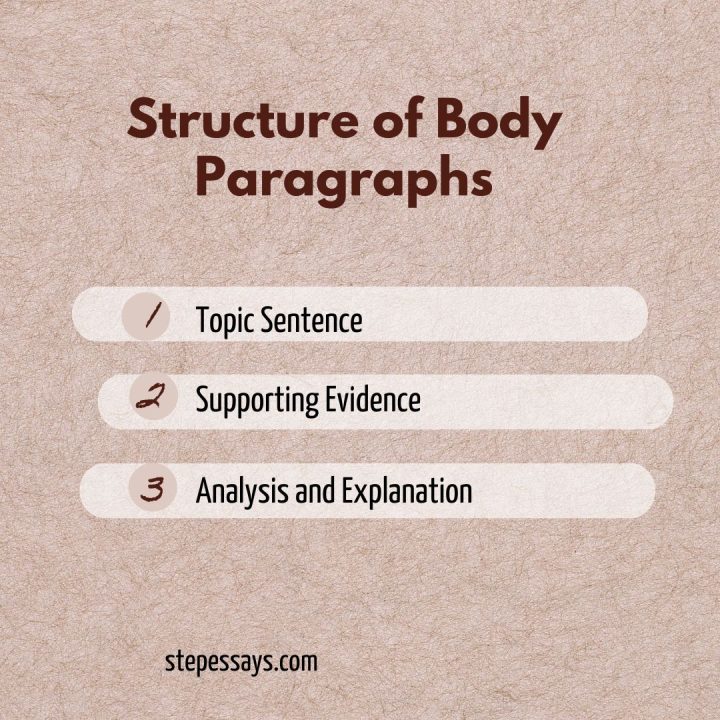Introduction:
Body paragraphs are the essence of any well-written essay. They serve as the building blocks where you present your arguments, provide evidence, and develop your ideas coherently. Crafting perfect body paragraphs is crucial for effectively conveying your message and persuading your audience. In this comprehensive guide, we will look into the strategies and techniques that will help you write impeccable body paragraphs, ensuring clarity, cohesion, and persuasive power in your essays.
Understanding the Structure of Body Paragraphs:

Body Paragraphs
Before diving into the steps of writing body paragraphs, it’s essential to grasp their fundamental structure. Each body paragraph should consist of three key elements.
- Topic Sentence: This sentence introduces the main idea or argument of the paragraph. It serves as a roadmap for the reader, guiding them on what to expect in the following sentences.
- Supporting Evidence: After presenting the topic sentence, you need to provide evidence to support your claim. This evidence can be in the form of examples, statistics, quotations, or anecdotes, depending on the nature of your essay.
- Analysis and Explanation: Once you’ve presented your evidence, it’s crucial to analyze and explain how it relates to your main argument. This step demonstrates your critical thinking skills and ensures that your arguments are well-grounded and logical.
Now that we’ve outlined the basic structure let’s explore the strategies for writing each component effectively.
Crafting Compelling Topic Sentences of Body Paragraphs
Topic sentences play a pivotal role in guiding the reader through your essay and setting the tone for the paragraph. Here are some tips for crafting compelling topic sentences:
- Be Clear and Concise: Your topic sentence should clearly state the main idea of the paragraph in a concise manner. Avoid ambiguity and ensure that your reader understands the purpose of the paragraph from the outset.
- Make it Specific: Instead of using vague or broad statements, strive to make your topic sentences specific and focused. This specificity helps maintain coherence and keeps your argument on track.
- Connect to the Thesis Statement: Your topic sentence should be closely related to your thesis statement, as it contributes to the overall argument of your essay. Make sure there is a clear connection between the two to maintain coherence and unity.
- Engage the Reader: A well-crafted topic sentence not only informs the reader of the paragraph’s content but also triggers their interest and encourages them to continue reading. Consider using rhetorical questions, vivid descriptions, or provocative statements to captivate your audience.
- Provide a Transition: In addition to introducing the main idea of the paragraph, your topic sentence should also serve as a transition from the previous paragraph. This helps maintain the flow of your essay and ensures smooth transitions between ideas.
Here’s an example of a strong topic sentence
“Climate change poses a grave threat to global biodiversity, as evidenced by the rapid decline in polar bear populations in the Arctic region.”
Supporting Your Claims with Evidence
Once you’ve established the main idea with a clear topic sentence, it’s time to provide evidence to support your argument. Here are some strategies for effectively incorporating evidence into your body paragraphs.
- Choose Relevant and Credible Sources: When selecting evidence to support your claims, prioritize sources that are relevant, credible, and authoritative. This could include peer-reviewed studies, expert opinions, or primary sources.
- Provide Specific Examples: Concrete examples can add depth and credibility to your argument. Whether it’s a case study, historical event, or personal anecdote, make sure your examples are specific and directly related to your main point.
- Use Statistical Data: Statistics can be a powerful tool for bolstering your argument and lending credibility to your claims. When using statistics, ensure they are from reliable sources and are presented accurately and clearly.
- Incorporate Quotations: If you’re discussing a particular text or author, incorporating direct quotations can strengthen your argument and provide textual evidence to support your analysis. Be sure to properly cite any quotations according to the required citation style.
- Provide Context and Explanation: Simply presenting evidence is not enough; you must also analyze and explain how it supports your argument. Provide context for your evidence and articulate its significance in relation to your main point.
Analyzing and Explaining Your Evidence
After presenting your evidence, it’s essential to analyze and explain how it reinforces your argument. Here are some strategies for effectively analyzing evidence in your body paragraphs.
- Interpret the Evidence: Don’t just present your evidence; take the time to interpret it and explain its significance. What does the evidence reveal about your argument? How does it contribute to your overall thesis?
- Consider Counterarguments: Anticipate potential counterarguments to your claims and address them proactively in your analysis. This demonstrates critical thinking and strengthens your argument by acknowledging and refuting opposing viewpoints.
- Provide Context: Place your evidence within the broader context of your essay and the topic at hand. Help your reader understand why this evidence is relevant and how it fits into the larger narrative you’re constructing.
- Highlight Patterns and Trends: If you’re presenting multiple pieces of evidence, look for patterns or trends that emerge. Analyze these patterns and explain their significance in relation to your argument.
- Tie Back to the Thesis: Always ensure that your analysis ties back to your thesis statement and reinforces the central argument of your essay. This helps maintain focus and coherence throughout your paper.
Conclusion:
Mastering the art of crafting perfect body paragraphs is essential for writing compelling and persuasive essays. By understanding the structure of body paragraphs and employing effective strategies for writing topic sentences, supporting evidence, and analysis, you can elevate the quality of your writing and effectively communicate your ideas to your audience. Remember to strive for clarity, coherence, and logical progression in your body paragraphs, and your essays will undoubtedly leave a lasting impression. With practice and dedication, you can hone your skills and become a proficient essay writer capable of crafting engaging and impactful academic papers.
